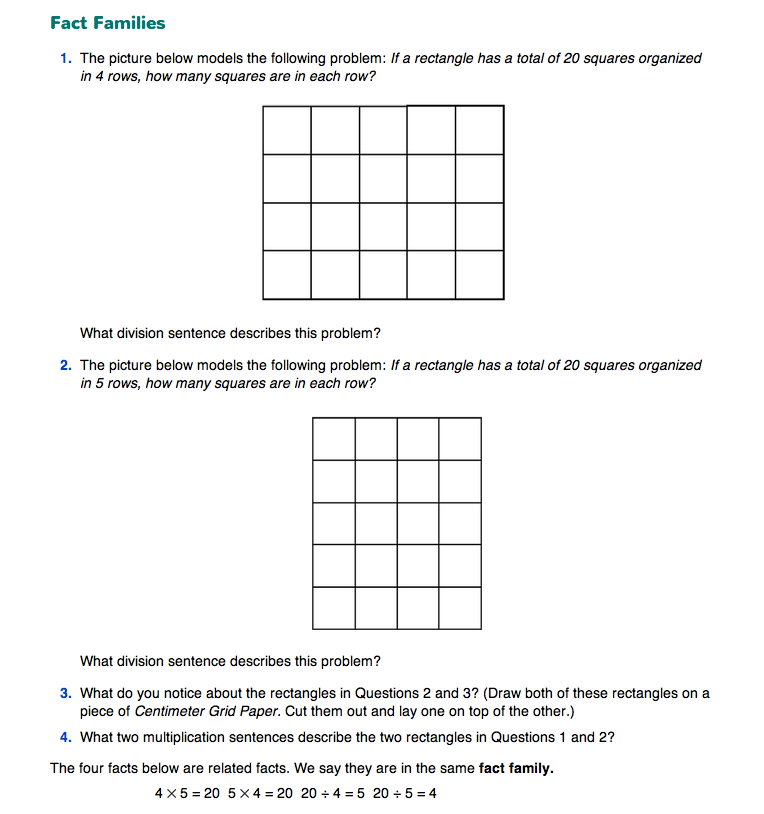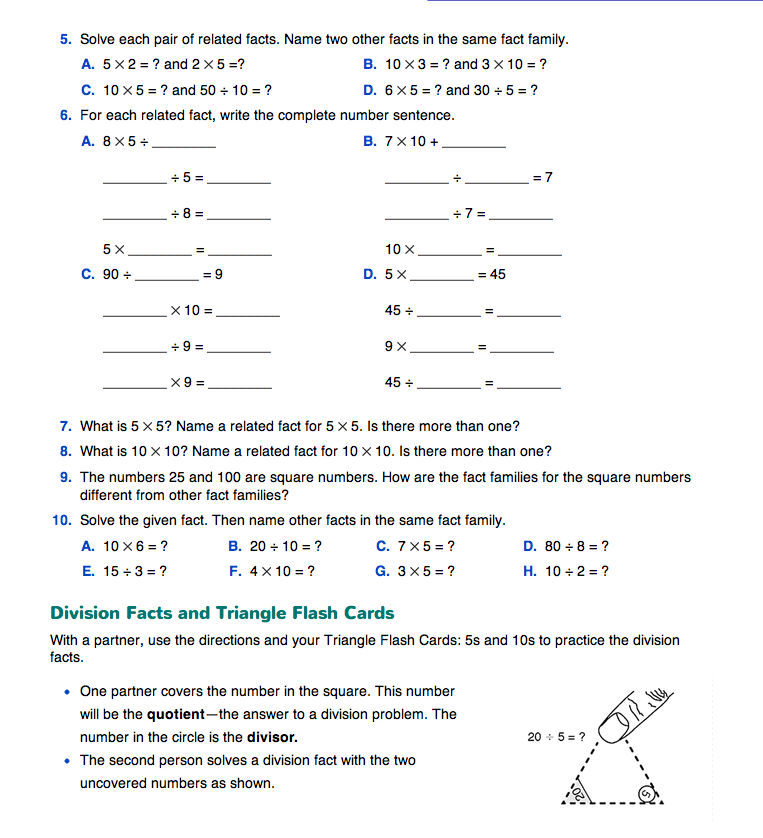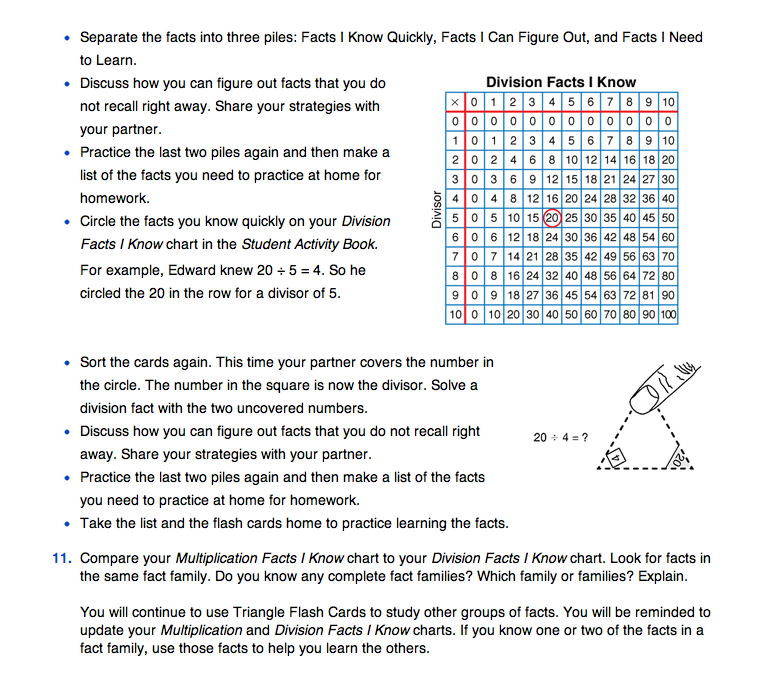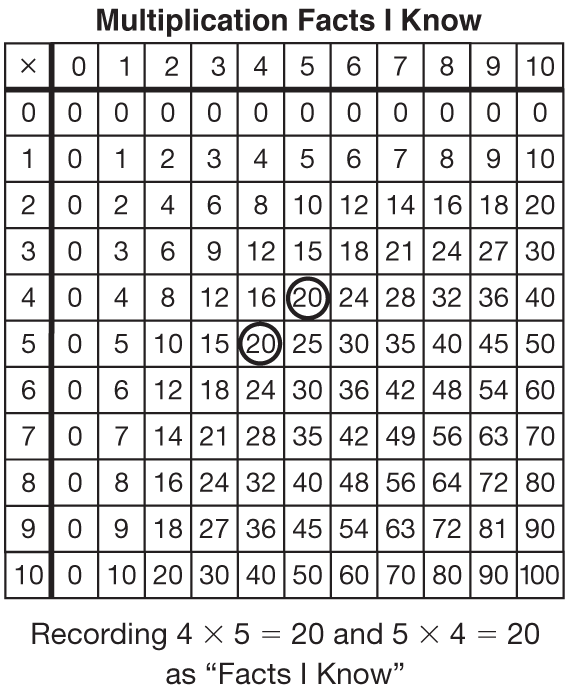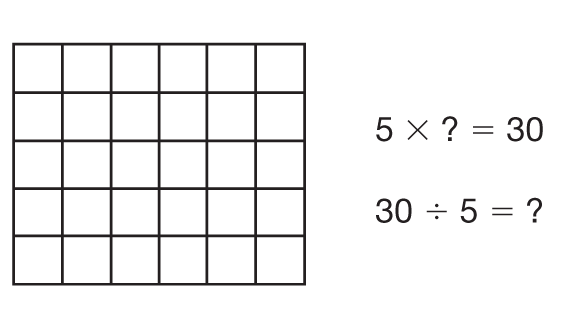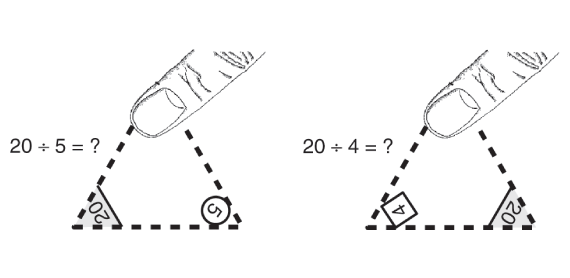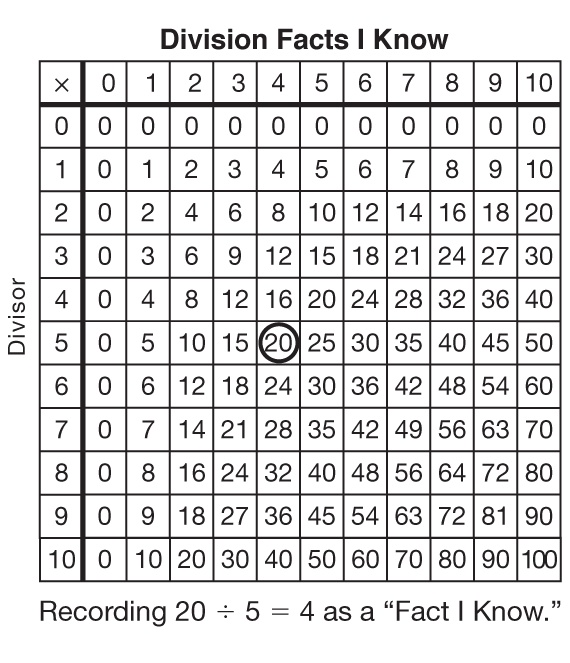Facts I Know
Est. Class Sessions: 1–2Developing the Lesson
Multiplication Facts and Triangle Flash Cards. The Multiplication Facts and Triangle Flash Cards section of the Facts I Know pages in the Student Guide outlines how students use the Triangle Flash Cards to practice the multiplication facts, and Part 1 of Home Practice provides a quick review.
Once students have sorted all their cards into three groups: Facts I Know Quickly, Facts I Can Figure Out, and Facts I Need to Learn, have them record their results on the Multiplication Facts I Know chart in the Student Activity Book. Figure 1 illustrates how to do this with one set of facts. Throughout the year, students will be reminded to update these charts.
Ask students to discuss strategies for figuring out answers to the multiplication facts they need to practice. Some examples of strategies follow.
- Skip counting: This strategy is only efficient for a small number of facts. 2 × 3 = … 2, 4, 6.
- Doubling: 7 × 4 may be solved by doubling the answer to 7 × 2. 7 × 2 = 14. 14 + 14 = 28.
- Using known facts: Knowing 5 × 5 is 25 may help in solving 5 × 6. 5 × 5 = 25. 25 + 5= 30.
- Patterns in the 9s: The sum of the digits of the products is 9. For example, 9 × 5 = 45. 4 + 5 = 9.
Students should not spend time practicing the facts they already know. Therefore, after the flash cards are sorted and the Multiplication Facts I Know charts have been updated, ask students to make a list of the facts in the other two piles—those facts they can figure out and those they need to learn. Students should take this list home along with their flash cards so that they can study the facts.
Fact Families. Give each student a copy of the Centimeter Grid Paper Master.
Ask:
Have students solve the problem by creating such a rectangle on the Centimeter Grid Paper. The rectangle should be made up of 5 rows of 6 squares. See Figure 2.
Ask:
This question can be viewed as a multiplication problem with a missing number: 5 × ? = 30. It can also be viewed as a division problem: 30 ÷ 5 = ? Have students label their rectangles with both number sentences: 5 × 6 = 30 and 30 ÷ 5 = 6.
Ask:
Ask students to solve this problem using the Centimeter Grid Paper. Your students should recognize that this problem results in a rectangle similar to the one they created earlier. This time there are 6 rows of 5 squares. See Figure 3.
Ask:
Ask students to label their second rectangle with both number sentences: 6 × 5 = 30 and 30 ÷ 6 = 5. Emphasize the fact that the two rectangles are the same by having students cut out both rectangles and laying one directly on top of the other. You can demonstrate this using a display of the Centimeter Grid Paper Master.
Since the four number sentences (6 × 5 = 30, 5 × 6 = 30, 30 ÷ 5 = 6, and 30 ÷ 6 = 5) all represent the same rectangle, we can see that these four facts are related. These four related facts are in the same fact family.
As appropriate, have students create more rectangles on the Centimeter Grid Paper to illustrate fact families. Questions 1–4 in the Fact Families section on the Facts I Know pages in the Student Guide provide another example using the facts 4 × 5, 5 × 4, 20 ÷ 4, and 20 ÷ 5. Have student pairs complete them.
Questions 5–10 provide multiplication and division fact practice for the 5s and 10s. Fact families are emphasized throughout. Students' knowledge of the multiplication facts and turn-around facts helps them review the division facts.
Questions 7–9 focus on the square facts 5 × 5 = 25 and 10 × 10 = 100. Since the two factors in each of these number sentences are the same, the fact families for these are different from other families. 5 × 5 = 25 and 25 ÷ 5 = 5 are the only two facts in this fact family. Likewise, 10 × 10 = 100 and 100 ÷ 10 = 10 are the only two facts in this fact family.
Division Facts and Triangle Flash Cards. The Division Facts and Triangle Flash Cards section in the Student Guide outlines how students use the Triangle Flash Cards to practice the division facts, and Part 1 of Home Practice provides a quick review. Students use the cards as they did to practice the multiplication facts, but students will need to sort the cards twice, once for each division fact in the fact family. See Figure 4.
Have students read through the directions in pairs as they practice and sort the facts. Once students have sorted their cards and shared their strategies, direct students' attention to a display of the Division Facts I Know chart from the Student Activity Book. Use Edward's example to demonstrate how to use the chart. Since Edward divided by 5 (20 ÷ 5 = 4), 5 is the divisor. He followed the 5 across its row to find the 20 he should circle. See Figure 5. Remind students that they circle only those facts that were in the pile of facts they know and can answer quickly. They should make a list of those facts. Students should take this list home along with the flash cards so they can study the facts.
















